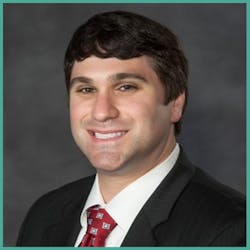Ryan Vega, M.D., is a hospitalist with the U.S. Department of Veterans Affairs (VA) where he serves as the executive director of the VHA Innovation Ecosystem in the Office of Discovery, Education and Affiliate Networks. He leads an effort called “VA Diffusion of Excellence.” Healthcare Innovation Senior Editor David Raths recently spoke with Dr. Vega about his team’s efforts to identify and scale up best practices across the VA.
Healthcare Innovation: How and why did the VA create a network of innovators across its medical centers?
Vega: Several years ago, a presidential innovation fellow named Andrea Ippolito saw the need to build better capacity in the field to manage innovation. She saw an opportunity to create what has become our Innovators Network. The premise was that there were VA sites that were doing amazing things, but the work needed to be managed strategically. We can do a better job of bringing ideas to fruition in a more structured process in terms of how we prototype and measure real-world impact and replicate and scale innovation. The network started with eight sites in 2016. Andrea identified and worked with innovation specialists — folks doing great work in their medical centers trying to advance innovation. She brought elements of human-centered design and entrepreneurship design thinking to the group.
HI: Are most of these innovators clinicians?
Vega: They come from all areas. We have had administrators, doctors and nurses, speech therapists. These folks are on the front lines, seeing the challenges, and they have really good ideas and are willing to work to make those ideas come to fruition. That was a grass roots movement that has now grown. We have two directors of the program and 37 sites. They use a venture capitalist model called “spark, seed, spread.” It is a yearly competition for individuals across the organization who have great ideas. In the spark portion, they will invest up to $10,000 to see if an idea can come to fruition, and in the spread section, up to $200,000 to spread an idea to a couple of other sites to see if its impact can be replicated. In the past year they have trained close to 3,500 employees across the country. That program is a core part of the larger innovation ecosystem.
HI: How did you get involved in the innovation efforts at the VA?
Vega: I am a hospitalist. I came to the VA in the position of chief resident for quality and safety. I went out to Intermountain Healthcare and trained under Brent James in his advanced training program in healthcare research and quality. Thinking of where health systems are going in terms of continuous quality, you hear terms such as high-reliability learning organization. Someone once said at the intersection of high reliability and innovative culture is cultural transformation – becoming these organizations that deliver the highest quality care is all about the culture. Whether you go to Mayo Clinic or the Richmond VA, where I come from, there is something about these cultures that is allowing innovation, whether it is 3D printing or advanced robotics and advanced prosthetics. I was attracted to that in the quality and safety work.
HI: You have an element of your program called Diffusion of Excellence. Can you describe what that involves?
Vega: It is all about how you identify best practices in a large organization and scale them. That has always been a challenge. Diffusion of Excellence is one of the core parts of our innovation ecosystem. The VA has amazing things going on across the organization but variability exists because of a difficulty of knowing what is going on from site to site. It is hard to know what is going on in Alaska right now because I am in Richmond. That creates an opportunity to develop a mechanism to scale best practices across the organization more effectively, knowing that there is likely a VA medical center that has solved a challenge that another VA medical center is experiencing. How do you create the infrastructure to help those communities connect and adopt what is working at one place and iterate forward? One of the things we have done is create a shark tank. It gives people who have come up with an exemplary practice the opportunity to pitch their idea. Medical center directors across the country act as sharks and bid medical center resources to replicate it at their medical center. That created an infrastructure to do replication studies on exemplary practices across the organization. It also created an employee competition that is unique.
HI: Could you describe an example of one that has had a big impact?
Vega: Sure. Shannon Munro is a researcher in Virginia who spent years trying to find ways to reduce pneumonia. She saw there was some science behind preventing non-ventilator-associated pneumonia in elderly patients. She came up with something simple – the idea that oral hygiene reduces the bacterial burden in the oral cavity, which then cuts down on transfer of bacterial load from the mouth to the lung. She came up with an oral care bundle and introduced it at a nursing home and had great results – a 90 percent reduction in non-ventilator-associated pneumonia. She replicated it and published a study and then applied for the shark tank and won. Then the Houston VA Medical Center said they wanted that project and implemented it. The project showed the same impact at another medical center. The practice began to slowly grow at multiple sites across the country. The data has shown a dramatic reduction in non-ventilator-associated pneumonia. It is having a real impact on morbidity and mortality.
HI: Has there also been work related to best practices in telehealth?
Vega: Yes. We have a project in the national diffusion stage called “Tele-wound.” It started at one medical center using store-and-forward technology. Wound care is so important, whether it is post-operative or for a diabetic patient. Through telehealth, we can reach people in a more timely manner, but also in their homes. The idea is to have an individual in their home share images with a wound care nurse so he or she can monitor the healing of a wound instead of regularly bringing the individual back to a clinic. This allows us to monitor or intervene sooner if there is a problem with a wound. That went through shark tank, was replicated and was very successful. It has great support from our Office of Connected Care and now is in national implementation. It is something other health systems could benefit from because it is not just a challenge for us; it is something we see across all rural communities – access is always going to be a focal point and where we can use technology to deliver better care, we should.



